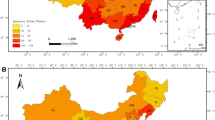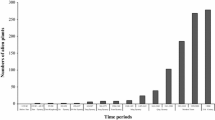Abstract
This study provides a detailed analysis of the invasion by Eupatorium adenophorum Spreng (Crofton weed) from Burma and Vietnam into Southern China since the 1940s. Currently, E. adenophorum’s main colonisation area is located in the Yunnan–Guizhou Plateau of China, where it has caused prominent economic and ecological problems. Sixty-three years ago, Crofton weed appeared in Menghai county, Yunnan Province, from where it dispersed northwards and eastwards at an average speed of 20 km year−1. The invasion of E. adenophorum nonetheless showed pronounced variations in both time and space. Spread was relatively slow in the initial invasion period between 1940 and 1950, while the most rapid range expansions occurred in the 1980s. Environmental conditions at native and invaded sites were significantly different, reflecting a great adaptability of the species during colonization. These changes were greater than habitat differences between colonized and many adjacent un-colonized sites in Southern China. Therefore, immediate measures are required to stop a further northward and eastward expansion of Crofton weed.



Similar content being viewed by others
References
Andrews AC, Falvey L (1979) The ecology of Eupatorium adenophorum in native and improved pastures in the northern Thailand highlands. In: Delfosse ES (ed) Proceedings of the 7th Asian-Pacific Weed Science Society conference, Sydney, Australia, pp 351–353
Auld BA (1970) Eupatorium weed species in Australia. Pest Articles News Summ 16(1):82–86
Auld BA (1981) Invasive capacity of Eupatorium adenophorum. In: Venkata Rao BV (ed) Proceedings of the 8th Asian Pacific Weed Science Society conference, Bangalore, India, pp 145–147
Baker HG (1986) Patterns of plant invasion in North America. In: Mooney HA, Drake JA (eds) Ecology of biological invasions of North America and Hawaii. Springer, Berlin, pp 44–57
Burke MJW, Grime JP (1996) An experimental study of plant community invasibility. Ecology 77:776–790
Cao YH (1993) A research on the flora of Nujiang dry-hot valley in Lujiangba of Yunnan. Acta Bot Yunnan 15:339–345
Chauvel B, Dessaint F, Cardinal-Legrand C, Bretagnolle F (2006) The historical spread of Ambrosia artemisiifolia L in France from herbarium records. J Biogeogr 33:665–673
Chen LZ (1993) Key taxonomies and areas of biodiversity protection in China. In: Chen LZ (ed) Status and countermeasures of biodiversity protection in China. Science Press, Beijing, pp 164–200 (in Chinese)
Delisle F, Lavoie C, Jean M, Lachance D (2003) Reconstructing the spread of invasive plants: taking into account biases associated with herbarium specimens. J Biogeogr 30:1033–1042
Electronic Sinomap (2004) Sinomaps Press, Beijing
Elton CS (1958) The ecology of invasions by animals and plants. Methuen, London
ESRI (2003) Arcview GIS, version 8.3. Environmental Systems Research Institute, Redlands
Fagan WF, Lewis MA, Neubert MG, van den Driessche P (2002) Invasion theory and biological control. Ecol Lett 5:148–157
Fisher RA (1937) The wave of advance of advantageous genes. Ann Eugen 7:255–369
Gosper H (2003) Crofton weed. NSW Agriculture. http://www.agric.nsw.gov.au/reader/weed-list
Graham CH, Ferrier S, Huettman F, Moritz C (2004) New developments in museum-based informatics and applications in biodiversity analysis. Trends Ecol Evol 19:497–503
Guo Q, Qian H, Richlefs R, Xi W (2006) Distributions of exotic plants in eastern Asia and North America. Ecol Lett 9:827–834
Henderson L (2001) Alien weeds and invasive plants. Plant Protection Research Institute Handbook No. 12. Plant Protection Research Institute, Pretoria, 300 pp
Hengeveld R (1989) Dynamics of biological invasions. Chapman and Hall, London
Kercher SM, Zedler JB (2004) Multiple disturbances accelerate invasion of reed canary grass (Phalaris arundinacea L.) in a mesocosm study. Oecologia 138:455–464
Lambrinos JG (2001) The expansion history of a sexual and asexual species of Cortaderia in California, USA. J Ecol 89:88–98
Li Z, Xie Y (2002) China invasion species. Forestry Publishing House, Beijing (in Chinese)
Lu P, Sang W, Ma K (2006) Effects of environmental factors on germination and emergence of Crofton weed (Eupatorium adenophorum). Weed Sci 54:452–457
Malanson GP (1993) Riparian landscapes. Cambridge University Press, Cambridge
Moody ME, Mack RN (1988) Controlling the spread of plant invasions: the importance of nascent foci. J Appl Ecol 25:1009–1021
Morris MJ (1989) Host specificity studies of leaf spot fungus Phacoramularia sp., for the biological control of Crofton weed (Ageratina adenophorum) in South Africa. Phytophylactica 21:281–283
Ponder WF, Carter GA, Flemons P, Chapman RR (2001) Evaluation of museum collection data for use in biodiversity assessment. Conserv Biol 15:648–657
Qiang S (1998) The history and status of the study on Crofton Weed (Eupatorium andenophorum spring.) a worst worldwide weed. J Wuhan Bot Res 16(4):366–372
Rejmánek M (1989) Invasibility of plant communities. In: Drake JA, Mooney HA, di Castri F, Groves RH, Kruger FJ, Rejmánek M, Williamson M (eds) Biological invasions: a global perspective. Wiley, Chichester, pp 369–388
Renöfält BM, Jansson R, Nilsson C (2005) Spatial patterns of plant invasiveness in a riparian corridor. Landsc Ecol 20:165–176
Sakai AK, Allendorf FW, Holt JS, Lodge DM, Molofsky J, With KA, Baughman S, Cabin RJ, Cohen JE, Ellstrand NC, McCauley DE, O’Neil P, Parker IM, Thompson JN, Weller SG (2001) The population biology of invasive species. Annu Rev Ecol Syst 32:305–332
Shigesada N, Kawasaki K (1997). Invasion of alien species. In: Shigesada N, Kawasaki K (eds) Biological invasions: theory and practice. Oxford series in ecology and evolution. Oxford University Press, Oxford, pp 26–27
Skellam JG (1951) Random dispersal in theoretical populations. Biometrika 38:196–218
Song QS, Fu Y, Tang JW, Feng ZL, Yang CR (2000) Allelopathic potential of Eupatorium adenophorum. Acta Phytoecol Sin 24:362–365 (in Chinese with English abstract)
Stadler J, Mungai G, Brandl R (1998) Weed invasion in East Africa: insights from herbarium records. Afr J Ecol 36:15–22
Verma TS, Minhas RS (1988) Effect of Eupatorium adenophorum in soil on growth, yield and nutrient in wheat. Crop Res 1(2):146–155
Wang HJ, He P, Ma JL (1994) An investigation and research report on the dissemination of Ageratina adenophora on rangeland areas in Liangshan District of Sichuan Province. Grassland China 1:62–64
Ward JV, Tockner K, Arscott DB, Claret C (2002) Riverine landscape diversity. Freshw Biol 47:517–539
Weber E (1998) The dynamics of plant invasions: a case study of three exotic goldenrod species (Solidago L.) in Europe. J Biogeogr 25:147–154
Williamson M (1996) Biological invasions. Chapman and Hall, London, pp 80–107
Williamson M, Preston C, Telfer M (2003) On the rates of spread of alien plants in Britain. In: Child LE, Brock JH, Brundu G, Prach K, Wade PM, Williamson M (eds) Plant invasions: ecological threats and management solutions. Backhuys, Leiden, pp 63–74
Williamson M, Pysek P, Jarosik V, Prach K (2005) On the rates and patterns of spread of alien plants in the Czech Republic, Britain, and Ireland. Ecoscience 12(3):424–433
Xiang YX (1991) Opinions on distribution, harmfulness, prevention and eradiation of Crofton weed. China Weed Sci 4:10–11
Xie Y, Li ZY, Gregg WP, Li DM (2001) Invasive species in China: an overview. Biodivers Conserv 10:1317–1341
Xu HG, Qiang S, Huang ZG (2004) Status surveying and effect analysis of alien invasive species in China. In: Xu HG, Wang JM, Qiang S, Wang CY (eds) Study of key issues under the convention on biological diversity: alien species invasion, biosafety, genetic resource. Science Press, Beijing, pp 21–22 (in Chinese)
Yunnan Meteorological Bureau (2000) Meteorology study on low latitude plateau. http://www.ynmb.net/dw/dwgy.htm]
Zhao GJ, Ma YP (1989) Investigation on the distribution and damage of Eupatorium adenophorum in Yunnan, China. Chin J Weed Sci 3:37–40 (in Chinese)
Acknowledgments
Mark Williamson, Richard Law and Jon Pitchford at the University of York, UK, and Julie S. Denslow at the Invasive Species Unit, Institute of Pacific Island Forestry, USDA Forest Service, as well as Zhenyu Li at the Institute of Botany, Chinese Academy of Sciences, all provided valuable suggestions and comments on this paper. The work was financially supported by the National Basic Research Program of China (973 Program 2009CB119200), the ‘‘111 program’’ from Bureau of Foreign Expert of China and Ministry of Education (contract no. 2008-B08044), and a KC Wong Fellowship by the Royal Society, UK. We are also most grateful to anonymous reviewer for constructive comments to the early versions of the manuscript.
Author information
Authors and Affiliations
Corresponding author
Rights and permissions
About this article
Cite this article
Sang, W., Zhu, L. & Axmacher, J.C. Invasion pattern of Eupatorium adenophorum Spreng in southern China. Biol Invasions 12, 1721–1730 (2010). https://doi.org/10.1007/s10530-009-9584-3
Received:
Accepted:
Published:
Issue Date:
DOI: https://doi.org/10.1007/s10530-009-9584-3




